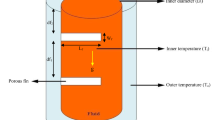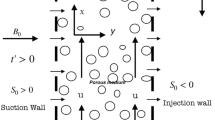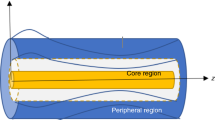Abstract
The ensuing study is dedicated to a series of numerical investigations concerning the effects of various geometric parameters of dimpled plates on the flow structure and heat transfer performance in a rectangular duct compared to the smooth plate. These parameters are the arrangement, number and depth of dimples. Two widely used staggered and square patterns in addition to a triangular arrangement, and three dimple depths (Δ = δ/d = 0.25, 0.375 and 0.5) have been chosen for this particular study. All studies have been conducted at three different Reynolds numbers Re = 25,000, 50,000 and 100,000. In order to capture the flow structures in the vicinity of dimples and contributing phenomena related to the boundary layer interactions, fully structured grids with y+ < 1 have been generated for all the cases. The realizable kt-ε two-layer model was selected as a proper turbulent model. It can be observed from the obtained results that higher effective area for heat transfer and a myriad of turbulent vortices mixing the hot fluid near the surface with the passing cold fluid generated from the downwind rims of dimples are the causes for improved average Nusselt number in the dimpled surface in comparison to the smooth plate. However, more pressure loss due to the higher friction drag and recirculation zones inside dimples will exist as a drawback in this system. Moreover, for all arrangements increasing dimple ratio Δ has a negative impact on the heat transfer augmentation and also deteriorates the pressure loss, which leads to this fact that Δ = 0.25 serves as the best option for the dimple depth.



















Similar content being viewed by others
Abbreviations
- c p :
-
Specific heat (J/kgK)
- d :
-
Dimple diameter (m)
- D h :
-
Hydraulic diameter (m) (=2HW/(H + W))
- f :
-
Friction factor
- f C :
-
Curvature correction factor
- h :
-
Convective heat transfer coefficient (W/m2K) (=\( \dot{q}/\left({T}_w-{T}_{\operatorname{Re}f}\right) \))
- H :
-
Height of channel (m)
- k :
-
Thermal conductivity (W/m2K)
- k t :
-
Turbulent kinetic energy (m2/s2)
- l :
-
Length of dimple plate (m)
- L :
-
Length of channel (m)
- L ref :
-
Reference length (m)
- \( \dot{m} \) :
-
Mass flow rate (kg/m3)
- Nu :
-
Nusselt number
- P :
-
Pressure (Pa)
- P t, abs :
-
Absolute total pressure (Pa)
- Pr :
-
PRANDTL number
- \( \dot{q} \) :
-
Heat flux (W/m2)
- Re :
-
Reynolds number
- S :
-
Distance between each adjacent dimple (m)
- T :
-
Temperature (K)
- T Re f :
-
Reference temperature (taken at inlet)
- T w :
-
Wall temperature
- u :
-
Velocity vector (m/s)
- V :
-
Average inlet velocity (m/s)
- w :
-
Width of dimple plate
- W :
-
Width of channel
- x :
-
Coordinate in stream-wise direction
- y :
-
Coordinate in span-wise direction
- δ :
-
Dimple depth (m)
- ρ :
-
Density (kg/m3)
- Δ:
-
Dimple ratio
- ΔP :
-
Pressure drop (Pa)
- y + :
-
Dimensionless wall distance
- η :
-
Performance factor \( \left(=\left(\overline{Nu}/\overline{Nu_o}\right)/{\left(f/{f}_o\right)}^{1/3}\right) \)
- ε :
-
Dissipation rate (m2/s3)
- μ :
-
Dynamic viscosity (Pa s)
- i, j :
-
Components in the x- and y-directions
- o :
-
Condition at smooth plate
- f :
-
Face of an boundary or interface
References
Wighart K (1953) Erhöhung des turbulenten Reibungswiderstandes durch Oberflachenstorugen. Forschung Schiffstech 1:65–68
Bearman P, Harvey J (1993) Control of circular cylinder flow by the use of dimples. AIAA J 31:1753–1756
Afanasyev V, Chudnovsky YP, Leontiev A, Roganov P (1993) Turbulent flow friction and heat transfer characteristics for spherical cavities on a flat plate. Exp Thermal Fluid Sci 7:1–8
Belen’kiy M, Gotovskiy M, Lekakh B, Fokin B, Dolgushin K (1993) Heat transfer augmentation using surfaces formed by a system of spherical cavities. Heat Trans Res 25:196–203
Chyu M, Yu Y, Ding H, Downs J, Soechting F (1997) Concavity enhanced heat transfer in an internal cooling passageASME 1997 International Gas Turbine and Aeroengine Congress and Exhibition American Society of Mechanical Engineers, pp. V003T009A080-V003T009A080
Moon H, O’Connell T, Glezer B (1999) Channel height effect on heat transfer and friction in a dimpled passageASME 1999 International Gas Turbine and Aeroengine Congress and Exhibition American Society of Mechanical Engineers, pp. V003T001A043-V003T001A043
Mahmood G, Hill M, Nelson D, Ligrani P, Moon H-K, Glezer B (2000) Local heat transfer and flow structure on and above a dimpled surface in a channelASME Turbo Expo 2000: Power for Land, Sea, and Air American Society of Mechanical Engineers, pp. V003T001A038-V003T001A038
Wang Z, Yeo KS, Khoo BC (2003) Numerical simulation of laminar channel flow over dimpled surface. AIAA paper 2964: 2003
Chen Y, Chew YT, Khoo BC (2012) Enhancement of heat transfer in turbulent channel flow over dimpled surface. Int J Heat Mass Transf 55:8100–8121
Grenard P, Quintilla-Larroya V, Laroche E (2007) Numerical study of heat transfer on a dimpled surface with CEDRE codeProc 2nd European Conf Aerospace Science
Kwon HG, Hwang SD, Cho HH (2011) Measurement of local heat/mass transfer coefficients on a dimple using naphthalene sublimation. Int J Heat Mass Transf 54:1071–1080
Liu J, Song Y, Xie G, Sunden B (2015) Numerical modeling flow and heat transfer in dimpled cooling channels with secondary hemispherical protrusions. Energy 79:1–19
Sangtarash F, Shokuhmand H (2015) Experimental and numerical investigation of the heat transfer augmentation and pressure drop in simple, dimpled and perforated dimpled louver fin banks with an in-line or staggered arrangement. Appl Therm Eng 82:194–205
Star-CCM+ Documentation V (2009) Tutorials CD-adapco
Shih T-H, Liou W, Shabbir A, Yang Z, Zhu J (1994) A new k-epsilon eddy viscosity model for high Reynolds number turbulent flows: Model development and validation
Hwang SD, Kwon HG, Cho HH (2008) Heat transfer with dimple/protrusion arrays in a rectangular duct with a low Reynolds number range. Int J Heat Fluid Flow 29:916–926
Gee DL, Webb R (1980) Forced convection heat transfer in helically rib-roughened tubes. Int J Heat Mass Transf 23:1127–1136
VDI-organization (2003) VDI heat Atlas. Springer
Bhatti M, Shah R (1987) Turbulent and transition flow convective heat transfer in ducts. Handbook of single-phase convective heat transfer, Chapter 4. John Willey & Sons, New York p 1–166
Slabaugh C, Le A, Kapat J (2009) A study of side wall heat transfer augmentation in a narrow rectangular duct45th AIAA/ASME/SAE/ASEE Joint Propulsion Conference & Exhibit, pp. 5377
Turnow J, Kornev N, Zhdanov V, Hassel E (2012) Flow structures and heat transfer on dimples in a staggered arrangement. Int J Heat Fluid Flow 35:168–175
Isaev S, Kornev N, Leontiev A, Hassel E (2010) Influence of the Reynolds number and the spherical dimple depth on turbulent heat transfer and hydraulic loss in a narrow channel. Int J Heat Mass Transf 53:178–197
Author information
Authors and Affiliations
Corresponding author
Rights and permissions
About this article
Cite this article
Nazari, S., Zamani, M. & Moshizi, S.A. Comparative study on the influence of depth, number and arrangement of dimples on the flow and heat transfer characteristics at turbulent flow regimes. Heat Mass Transfer 54, 2743–2760 (2018). https://doi.org/10.1007/s00231-018-2307-5
Received:
Accepted:
Published:
Issue Date:
DOI: https://doi.org/10.1007/s00231-018-2307-5




